DKosig/E+ via Getty Images
Before FTX (FTT-USD) collapsed in early to mid-November, many assets in the crypto market appeared to be setting up for favorable returns to end the year. Unfortunately for broad crypto bulls, FTX happened and 2022 is going to go down as one of the worst years for crypto investors since the industry really began with Bitcoin’s (BTC-USD) arrival in 2009. If Bitcoin closes the year at the current $17,750 level, 2022 will be the second worst single year performance for Bitcoin since 2011 by both year over year decline (-62%) and decline from all-time high (-74%). This bear market cycle looks a bit different from previous ones, however.
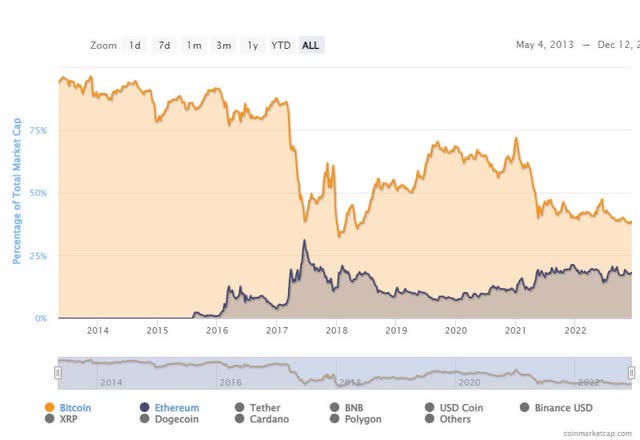
BTC & ETH Dominance (CoinMarketCap)
We saw Bitcoin’s crypto market dominance move from 32% during Ethereum’s (ETH-USD) early January 2018 peak back up to over 50% during the depths of the 2019 crypto market bottom. Bitcoin’s dominance continued to move higher as many altcoins from the ICO failed to regain all-time highs during the last bull run. Given the magnitude of the selloff in crypto to this point, Bitcoin’s 38% market dominance now is very low compared to previous cycles.
This time, assets other than Bitcoin have proven resilient in this current crypto winter cycle. Ethereum is notably stabilizing in the 18-20% market dominance range; ETH dominance figures that were previously indicators of peaks could now be transitioning to dominance bottoms if ETH is ever to flip BTC from a market dominance perspective. Even more impressive is Polygon (MATIC-USD) which is currently right near its dominance high of 0.9%.
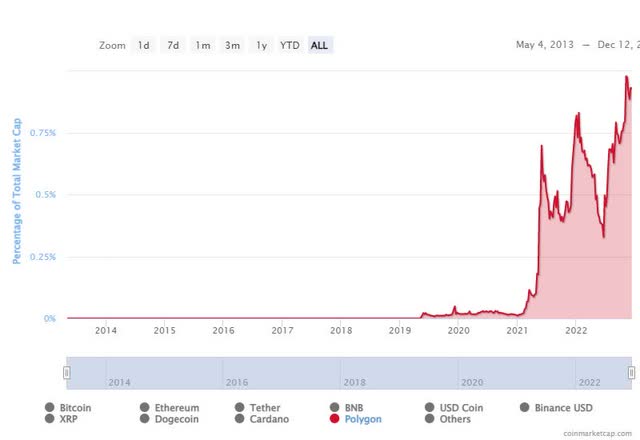
Polygon Dominance (CoinMarketCap)
Polygon has shown remarkable resilience in this bear market and I believe MATIC is in a terrific position to be one of the best performing assets next year. In this article, I’ll detail why Polygon is my top crypto pick for 2023. We’ll look at what Polygon is, assess network adoption metrics, valuation compared to peers, coin supply dynamics, and major risks to consider.
What is Polygon?
I’ve previously covered Polygon for Seeking Alpha here and here and for BlockChain Reaction subscribers here. Simply put, Polygon is a proof-of-stake blockchain specifically designed to bring better scaling to Ethereum. Like other layer 1 blockchains, Ethereum suffers from the ‘blockchain trilemma.’
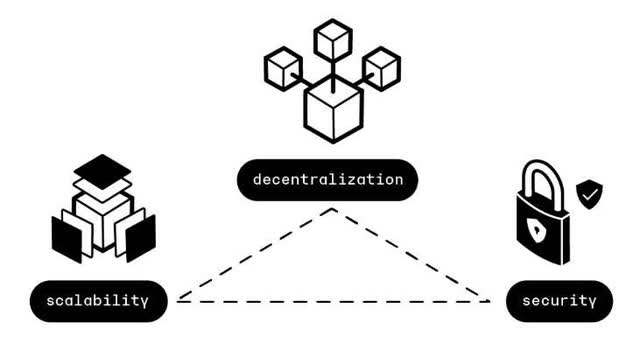
Blockchain Trilemma (Ledger)
The trilemma theory suggests public blockchains can’t achieve all three characteristics (decentralization, security, and scalability) independently. Ethereum is secure and decentralized but not scalable. Ethereum’s scalability problem has led to the proliferation of other base layer blockchains that aim to offer better scalability through faster block times and more transactions per second. Other attempts at solving Ethereum’s scalability drawback have come from building secondary “Layer 2” blockchains on top of Ethereum. This is the route Polygon has gone.
Through Polygon, developers can get fast, cheap transactions that are secured with Ethereum’s infrastructure. Anyone with an Ethereum wallet can use the Polygon network and interact with applications build on Polygon at a fraction of the cost associated with building on Ethereum. Rather than using ETH for gas fees, apps built on Polygon use MATIC for gas payment. These gas fees are so cheap per transaction that applications will often cover this cost for the end user – we’ll explore this more momentarily.
Partnerships
In spite of crypto winter, Polygon has been building an impressive list of partnerships with some of the top companies in the world. Polygon has been chosen as a public blockchain tool by Starbucks (SBUX), Meta Platforms (META), Stripe, and Reddit. Additionally, Polygon was the only blockchain scaling protocol that was granted presence in Disney’s (DIS) accelerator program earlier this year.
Starbucks is using Polygon to launch its new rewards platform, Starbucks Odyssey. While that platform is still in beta, demand for the product has reportedly been ‘unprecedented.’ It seems to work like most other rewards programs. The more a consumer engages with the product or service, Starbucks in this case, the more that consumer will generate rewards that can be redeemed for additional perks and benefits as a Starbucks customer. According to a recent Digiday piece, the crypto natives aren’t the only ones paying attention to how Starbuck’s NFT project performs:
Marketers and industry observers say they are watching the rollout of the program as it could be a bellwether for how much consumers are willing to care about branded NFTs.
Starbucks Odyssey isn’t live for the entire market yet, that comes next year. But if it’s received as well as Reddit’s Avatar Collectibles project has been, Polygon figures to onboard several million more non-crypto native users to the crypto ecosystem very shortly.
Reddit Avatar Collectibles
The biggest issue facing broader crypto adoption may not be regulatory clarity, institutional demand, or approval of ETFs. In my view, public blockchain gets to the next level when people are interacting with crypto rails without realizing it. We’re already beginning to see that with Polygon. Just about every crypto network has experienced drastic daily user declines since the Terra (LUNC-USD) collapse in May and June. Polygon has been a notable exception. This is in large part because people are indirectly buying MATIC without realizing it.
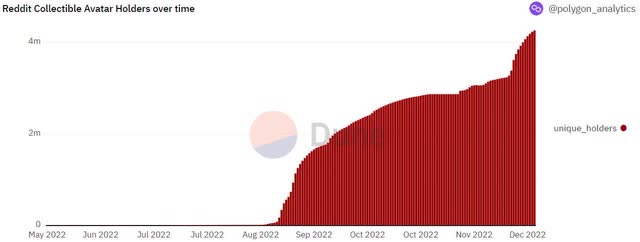
Reddit NFT Unique Holders (Dune Analytics/Polygon)
Reddit launched its Avatar Collectible NFT initiative back in July. Since then, the project has produced over 5 million collectible avatars; 3.9 million of which are from unique holders. According to Polygon, just 6.8% of the Reddit avatar holders have more than 1 avatar. This implies an impressive acceptance of the avatars by the Reddit community. Notable given the pushback regarding NFTs from certain communities earlier this year. NFTs have a bit of a stigma at the moment. The first thing that probably pops into the mind of the casual crypto spectator when they see the acronym “NFT” might be Bored Ape Yacht Club or Crypto Punks. The acronym is associated with people dropping silly amounts of money on JPEGs.
This has led to rejection from some who see NFTs as nothing more than yet another tulip mania. Ubisoft (OTCPK:UBSFY) and Discord (DSCD) both infamously dialed back their plans to launch NFT projects after pushback from the gamer community. So how did Reddit pull this off? Simple. The NFTs weren’t called NFTs. They were called “Digital Collectibles.” This is what Reddit CEO Steve Huffman told The Verge in August:
We try really hard not to use any crypto words — it just confuses people. The ecosystem is so confusing. I can’t figure out half this stuff.
By covering gas fees as part of the out the door product cost and being very careful to avoid any crypto-related words, Reddit has proven a very valuable case study in both NFT and crypto adoption. It’s just avatar pictures and other collectible NFTs today. But in the future, it’ll be much more than that; digital assets like usernames, websites domains, and content itself can theoretically live on scalable public blockchains like Polygon.
Network Activity
The Reddit project has provided a noticeable uptick in daily active users on the Polygon blockchain. There was actually a two week period in October when Polygon was averaging more DAUs than Ethereum was. That average has come off that high a bit and the chain is now averaging a little under 335k DAUs:
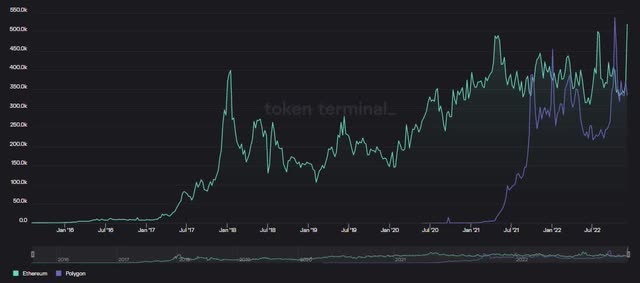
DAUs & Developers (TokenTerminal)
This level of activity has helped Polygon’s network stabilize in the 2-3 million daily transaction range despite the large declines in crypto-related transactions seen in other networks.
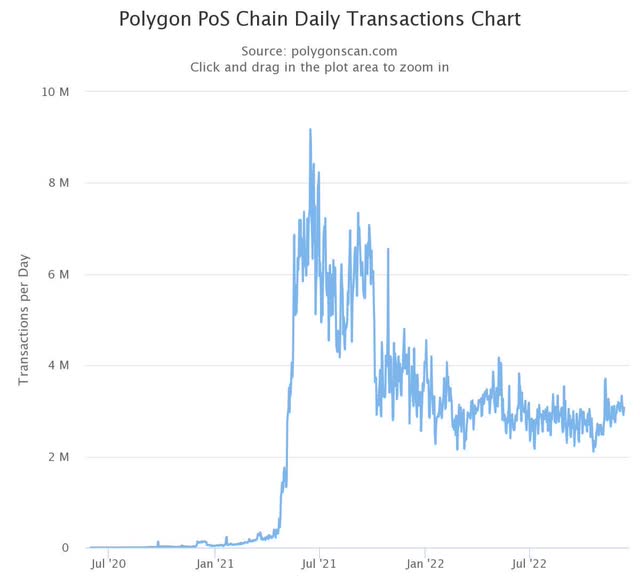
Daily Transactions (Polygonscan.com)
Polygon has had stable network engagement for all of 2022 even while numerous crypto-collapses have put a tremendous amount of pressure on the industry broadly, especially in NFTs.
Price to Fees Valuation
Valuing blockchains is a bit different from valuing traditional equities. Because the crypto industry is still so new, there isn’t really a set of standards for valuing a network’s token. This is especially true because crypto networks don’t necessarily serve the same kind of transaction demand. When it comes to something like payments, NVT or the network value to transactions ratio, is a solid fundamental metric to consider.
But for smart contracts, price to fees is of interest as well. It slightly mimics a price to sales ratio as it divides the fully diluted coin market cap by the annualized transaction fees on the network. When your network is all about cheap fees, this can create extremely elevated P/F ratios.
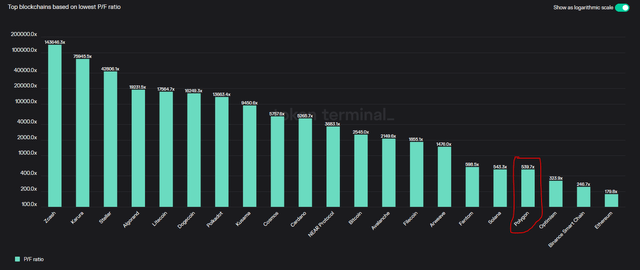
P/F Ratio comparison (Token Terminal)
Even though Polygon’s gas fees are less than a penny per transaction, the high P/F ratio issues isn’t really the case. Currently, the P/F ratio for Polygon is 540. This is higher than chains like Binance (BNB-USD) or Ethereum but much lower than other low-fee blockchains like Avalanche (AVAX-USD), Near Protocol (NEAR-USD), Cardano (ADA-USD), or Cosmos (ATOM-USD). When we look at the metric over time, we can see that Polygon has been growing into its P/F valuation:
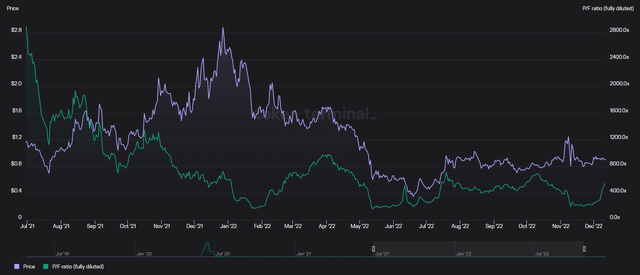
Polygon P/F Trend (Token Terminal)
Back in July of 2021, the price of MATIC was at a very similar level to where it is now but the P/F multiple was roughly 5x higher than it is today. This shows network growth of Polygon that is outpacing the growth of the MATIC token price.
Token Supply
For Polygon, the network growth story becomes very interesting when we assess the supply/demand mechanics of the token. Many Layer 1 blockchains, Ethereum included, don’t have a coin supply cap. Polygon is one that does:
- Tokens in circulation: 8.7 billion
- Max token supply: 10 billion
- Circulating supply: 87%
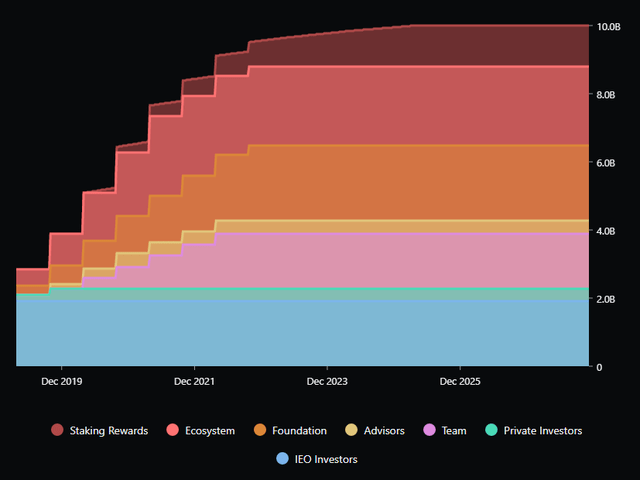
MATIC Supply schedule (Messari/Polygon)
All of the MATIC tokens will be in the circulating supply by mid-2025. Since the tokens are required for transactions on-chain whether the end user is aware of it or not, as the network grows there will always be an organic bid for MATIC as the key utility token on the network. With a token supply cap fast approaching, network demand should move the price of MATIC much higher.
Risks
As with any investment in crypto, Polygon carries significant regulatory risk in the United States. The market still requires clarity on if MATIC would be considered a synthetic commodity, currency, or a security. I will not attempt to handicap how the federal government views MATIC but in my opinion it would probably negatively impact the price of the coin to a larger degree if the SEC gets regulatory oversight of Polygon. There is also risk broadly speaking because digital assets are inherently riskier than traditional investments like equities or bonds.
There is also macro risk to consider. Until proven otherwise, the “fed pivot” narrative, to which I absolutely subscribe, is still just a thesis and has not yet happened. Additionally, even if the Fed pivots it may not be enough to bring more liquidity into the crypto ecosystem. I think Polygon is more reliant on the success of NFT initiatives from key brand partners like Starbucks, Meta, and Reddit than it is on the central banks. There is no guarantee that Starbucks or any other partner will have the product success that was seen with Reddit’s Avatar Collectibles. There is also no guarantee that these kinds of products will all be built with public blockchains.
Summary
Polygon has been one of the better performing crypto assets this year. In mid-June following the Terra/Celsius (CEL-USD) drama, the MATIC token hit $0.32 when crypto crashed. It is now up almost 200% since the June low and continues to on-board new users who are not crypto native. Polygon is working with several major brands on key growth initiatives. There is no guarantee any of these initiatives bear fruit for Polygon or its partners. But given the pedigree of Polygon’s partners, I can’t think of a crypto-native asset that is in a better position to bring new blood to crypto rails in 2023.
All that said, I don’t think we’ve seen the bottom yet in certain crypto assets. Frankly, I believe there are several crypto coins in the top 20-25 by market rank that will not last another 2 years. Polygon is different. As Reddit has shown us this year, the end user doesn’t necessarily even know they are using crypto when they engage with some of the products that are built with Polygon. This is a massive factor in my view. Even if crypto as an investment category falls apart in 2023, I believe the case can be made that MATIC will hold up just fine provided the network continues to onboard non-crypto natives through new product offerings from companies like Starbucks. If crypto doesn’t fall apart in 2023, MATIC will probably do even better.
Editor’s Note: This article was submitted as part of Seeking Alpha’s Top 2023 Pick competition, which runs through December 25. This competition is open to all users and contributors; click here to find out more and submit your article today!
Credit: Source link






















 Bitcoin
Bitcoin  Ethereum
Ethereum  Tether
Tether  Solana
Solana  USDC
USDC  XRP
XRP  Lido Staked Ether
Lido Staked Ether  Toncoin
Toncoin  Dogecoin
Dogecoin  Cardano
Cardano  Shiba Inu
Shiba Inu  Avalanche
Avalanche  TRON
TRON  Wrapped Bitcoin
Wrapped Bitcoin  Polkadot
Polkadot  Bitcoin Cash
Bitcoin Cash  Chainlink
Chainlink  NEAR Protocol
NEAR Protocol  Polygon
Polygon  Litecoin
Litecoin  Fetch.ai
Fetch.ai  LEO Token
LEO Token  Internet Computer
Internet Computer  Dai
Dai  Uniswap
Uniswap  Render
Render  Ethereum Classic
Ethereum Classic  Hedera
Hedera  First Digital USD
First Digital USD  Aptos
Aptos  Pepe
Pepe  Cosmos Hub
Cosmos Hub  Cronos
Cronos  Mantle
Mantle  Immutable
Immutable  Wrapped eETH
Wrapped eETH  Filecoin
Filecoin  Stellar
Stellar  dogwifhat
dogwifhat  OKB
OKB  Stacks
Stacks  Renzo Restaked ETH
Renzo Restaked ETH  The Graph
The Graph  Optimism
Optimism  Arbitrum
Arbitrum  Arweave
Arweave  Bittensor
Bittensor  Maker
Maker 
